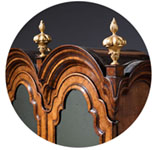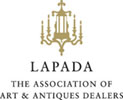17th Century William and Mary Marquetry Longcase Clock, Signed Apply
Sold
Request Information
Follow Us
17th Century William and Mary Marquetry Longcase Clock, Signed Apply
A wonderful late seventeenth-century rising hood 10-inch William and Mary eight-day floral marquetry olive oyster longcase clock by Edmund Appley, London, c. 1680-1685.
The attractive and fine olive oyster-veneered case is of the highest quality and decorated throughout in floral and leaf marquetry depicting spring flowers, a bird and scrolling foliage, each on a ground of ebony within a panel bordered with boxwood.
The trunk door reflects the ebonised mouldings and pillars on the hood and is bordered by an ebonised D-moulding with a circular lenticle set within an ebonised moulding. The rising hood is decorated with fine scrolling blind fretwork and cavetto moulding, flanked by tapering ebonised barley-twist columns. Large linear viewing windows of glass sit to each side of the hood.
The cross-banded sides have been carefully thought out too, with small sections of saw-cut olive oyster veneer, each carefully book-matched.
Raised on four ebonised bun feet.
The whole case is of extremely good colour and has the most lovely age-patinated surfaces.
The eight-day five pillar movement has going and striking trains. The striking train is regulated by an inside countwheel (the detent mounted externally and engaging through a slot in the backplate). The going train has anchor escapement with bolt and shutter maintaining power and a seconds pendulum. The backplate is mounted with a brass L-shaped bracket located against a conforming iron bracket set into the backboard.
The 10-inch brass dial has a solid silver chapter ring, seconds ring and date aperture. A wonderful sign of quality. The silver chapter ring is divided into Roman hour numerals as well as quarter-hour, fleur-de-lys half-hour, Arabic five-minute and minute divisions. It is surrounded by solid silver winged cherub-head spandrels in the corners and is signed along the bottom of the brass plate “Edmund Appley Charing Cross”. The centre is finely matted, showing the shutters in a closed position, whilst the time is indicated by a fine pair of richly pierced blued-steel hands.
The maker
Edmund Appley was born the son of Humphrey Appley, a weaver, in 1656. He was apprenticed to Jeffrey Bayley in 1670 and made free in London in 1677. From 1681 he took apprentices himself, working in Charing Cross. He died on a visit to Edinburgh in 1688 and was buried there. Longcase clocks, bracket clocks and lantern clocks by his hand are known.
Height 198 cm with a height of 225 cm with the hood raised to wind.
Condition
Good. Wear consistent with age and use.
Dimensions
Height: 198 cm (77.96 in)
Width: 39 cm (15.36 in)
Depth: 22.5 cm (8.86 in)
PREVIOUSLY SOLD
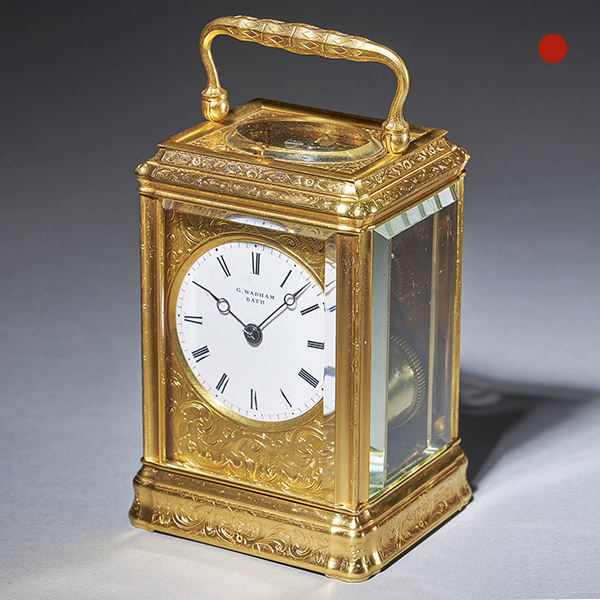
19th Century Gilt-Brass Engraved Striking and Repeating Carriage Clock
19th Century Gilt-Brass Engraved Striking and Repeating Carriage Clock Sold Follow Us19th Century Gilt-Brass Engraved Striking and Repeating Carriage Clock The superb engraved gilt brass gorge case has facetted glass panels to all sides so...
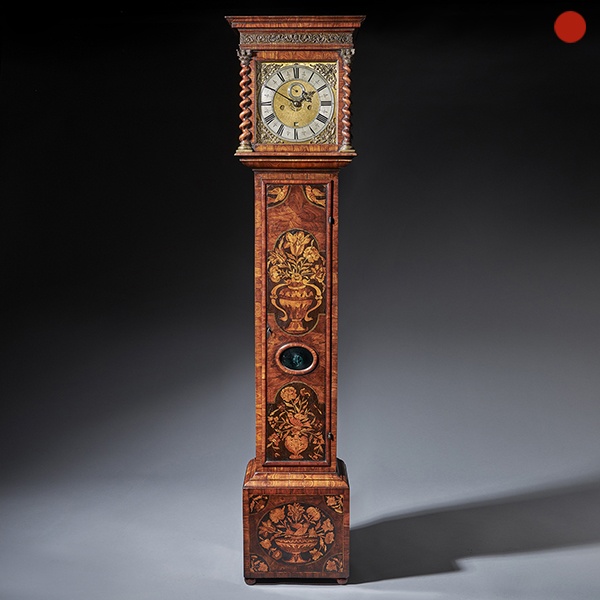
Important Charles II 17th Century Princes Wood and Marquetry Longcase Clock
Important Charles II 17th Century Princes Wood and Marquetry Longcase Clock SOLD Follow UsImportant Charles II 17th Century Princes Wood and Marquetry Longcase Clock A unique and important Charles II 17th century month-going Princes wood and...
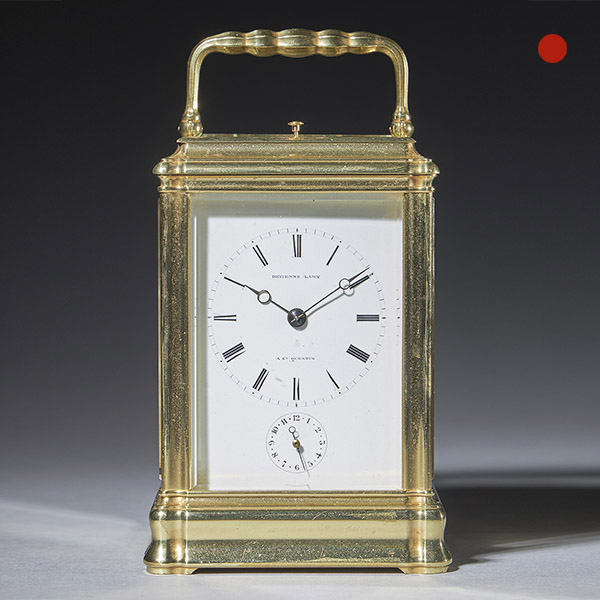
A Rare And Unusual 19th-Century Carriage Clock Signed Devienne Lamy A St Quentin, Circa: 1860
A Rare And Unusual 19th-Century Carriage Clock Signed Devienne Lamy A St Quentin, circa 1860. The gorge case has bevelled glass panels on all sides.
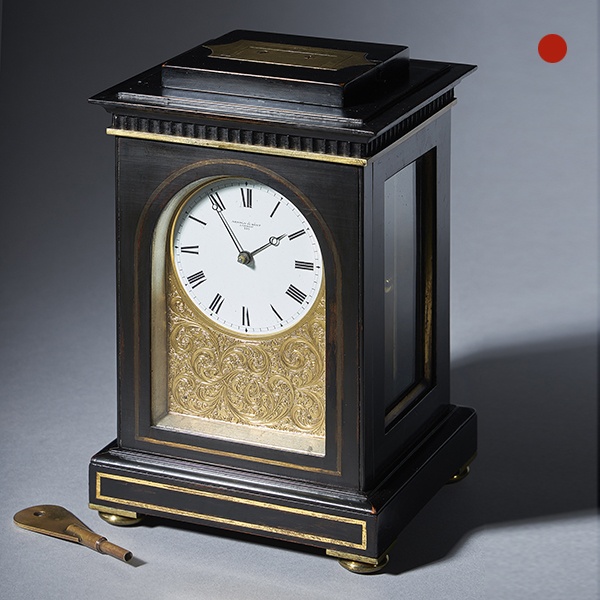
A Unique And Fine Mid 19th-Century Travelling Clock By Celebrated Makers Arnold & Dent, London
Unique and Fine Mid 19th-Century Travelling Clock By Celebrated Makers Arnold & Dent, London. The time is indicated by a fine pair of blued-steel Breguet hands.
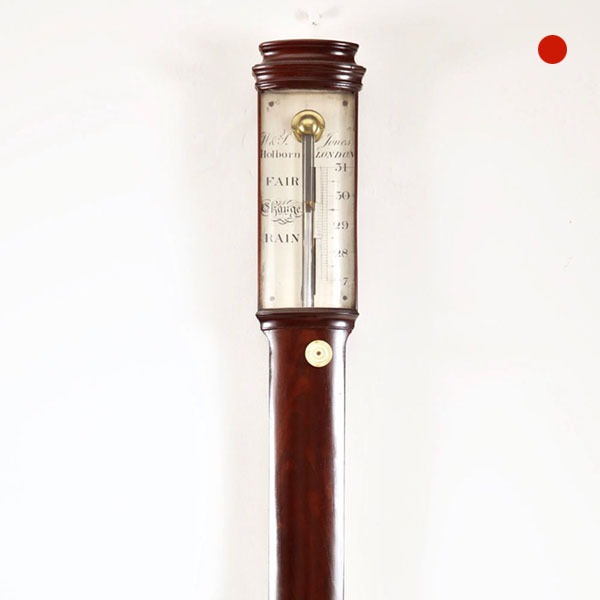
A fine 18th-Century George III mahogany bow-front stick barometer
The mahogany-veneered case has an austere form with only the moulded caddy top and the urn-shaped cistern cover to break its soberness. The silvered register plates are protected by a bowed glass, the recorder with vernier scale being operated by a knob below the register plate.
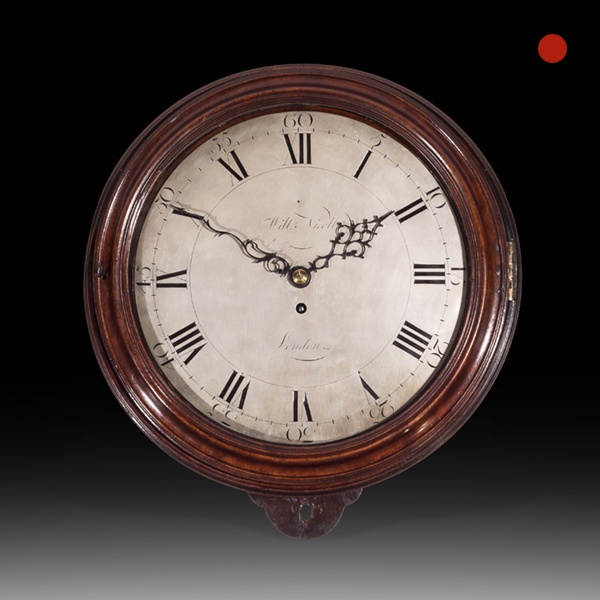
Large Mahogany 18th-Century Dial Clock, William Nicoll, London
The solid mahogany case has a moulded mahogany glazed door, which can be locked on the left-hand side. The original rectangular saltbox is permanently attached to the front and has doors to the side and the bottom.

19th Century Gilt-Brass Engraved Striking and Repeating Carriage Clock
19th Century Gilt-Brass Engraved Striking and Repeating Carriage Clock Sold Follow Us19th Century Gilt-Brass Engraved Striking and Repeating Carriage Clock The superb engraved gilt brass gorge case has facetted glass panels to all sides so...

Important Charles II 17th Century Princes Wood and Marquetry Longcase Clock
Important Charles II 17th Century Princes Wood and Marquetry Longcase Clock SOLD Follow UsImportant Charles II 17th Century Princes Wood and Marquetry Longcase Clock A unique and important Charles II 17th century month-going Princes wood and...

A Rare And Unusual 19th-Century Carriage Clock Signed Devienne Lamy A St Quentin, Circa: 1860
A Rare And Unusual 19th-Century Carriage Clock Signed Devienne Lamy A St Quentin, circa 1860. The gorge case has bevelled glass panels on all sides.

A Unique And Fine Mid 19th-Century Travelling Clock By Celebrated Makers Arnold & Dent, London
Unique and Fine Mid 19th-Century Travelling Clock By Celebrated Makers Arnold & Dent, London. The time is indicated by a fine pair of blued-steel Breguet hands.

A fine 18th-Century George III mahogany bow-front stick barometer
The mahogany-veneered case has an austere form with only the moulded caddy top and the urn-shaped cistern cover to break its soberness. The silvered register plates are protected by a bowed glass, the recorder with vernier scale being operated by a knob below the register plate.

Large Mahogany 18th-Century Dial Clock, William Nicoll, London
The solid mahogany case has a moulded mahogany glazed door, which can be locked on the left-hand side. The original rectangular saltbox is permanently attached to the front and has doors to the side and the bottom.
YOU MAY ALSO LIKE
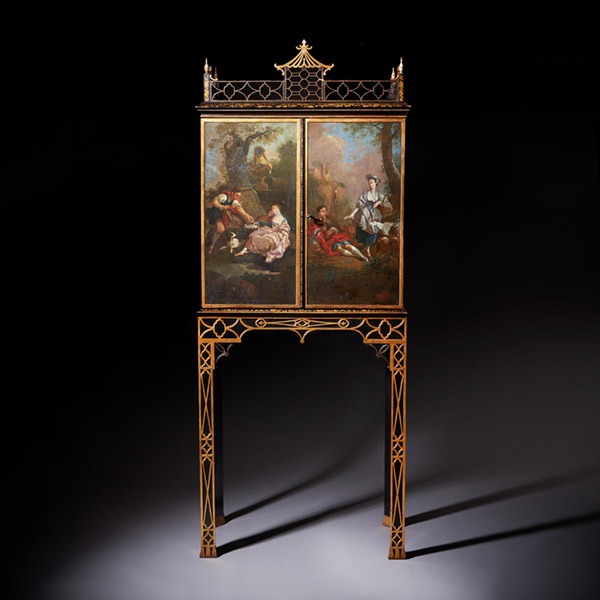
A Rare Chinese Chippendale George III cabinet on stand, circa 1760 England
A Rare Chinese Chippendale George III cabinet on stand, circa 1760. England £38,000Follow UsA Rare...
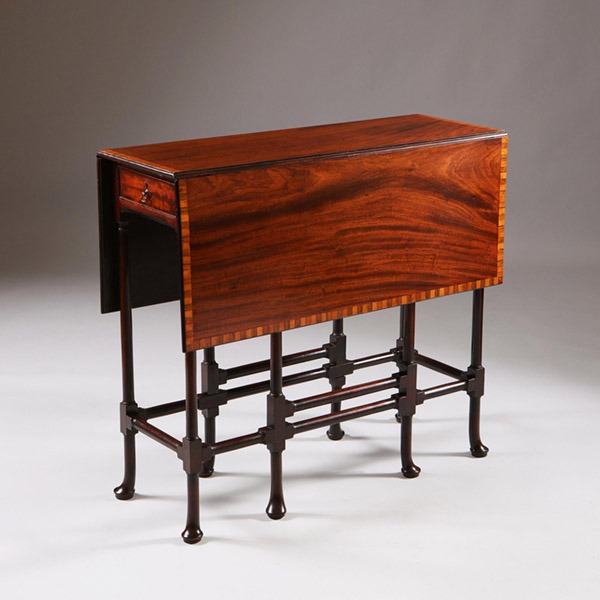
George III mahogany spider-leg table attributed to Thomas Chippendale 1768
A George III mahogany spider-leg table attributed to Thomas Chippendale 1768 £12,000Follow UsA...
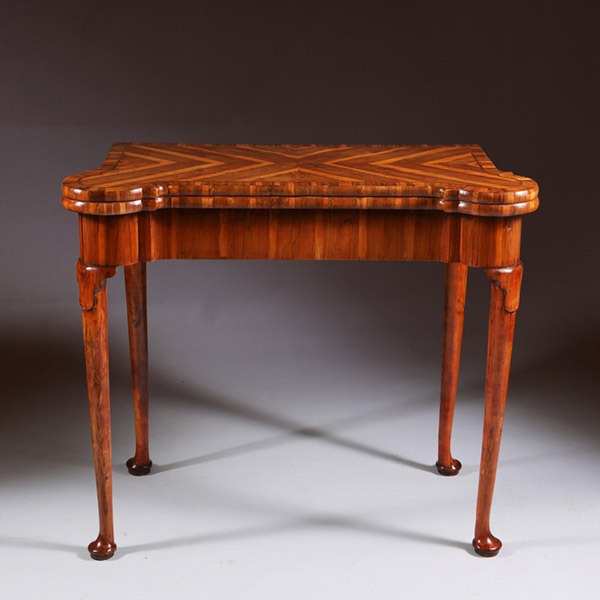
Museum Grade George I Cocus Wood Card Table, Circa 1725, England
Museum Grade George I Cocus Wood Card Table, Circa 1725. England £32,000Follow UsMuseum Grade...
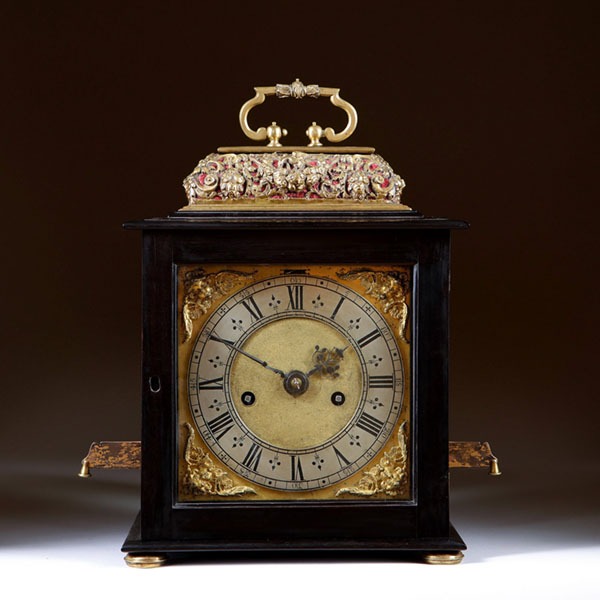
A Rare and Important Charles II 17th Century Table Clock by Henry Jones
A Rare and Important Charles II 17th Century Table Clock by Henry Jones £85,000Follow UsA Rare and...
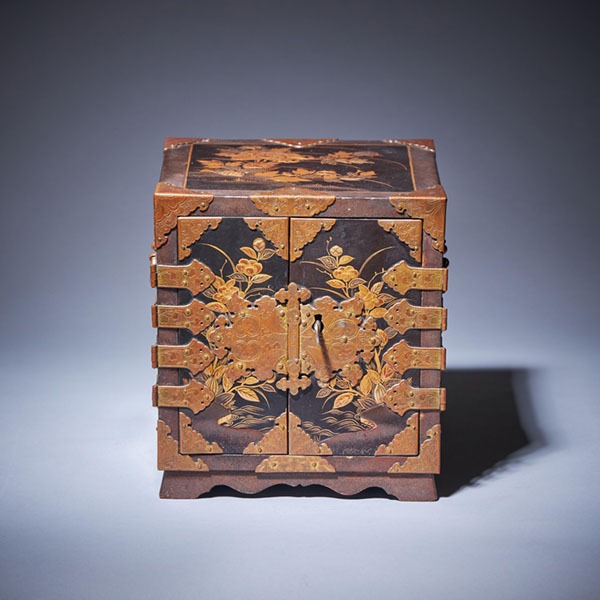
Important Early Edo Period 17th Century Miniature Japanese Lacquer Cabinet
Important Early Edo Period 17th Century Miniature Japanese Lacquer Cabinet £36,000Follow...
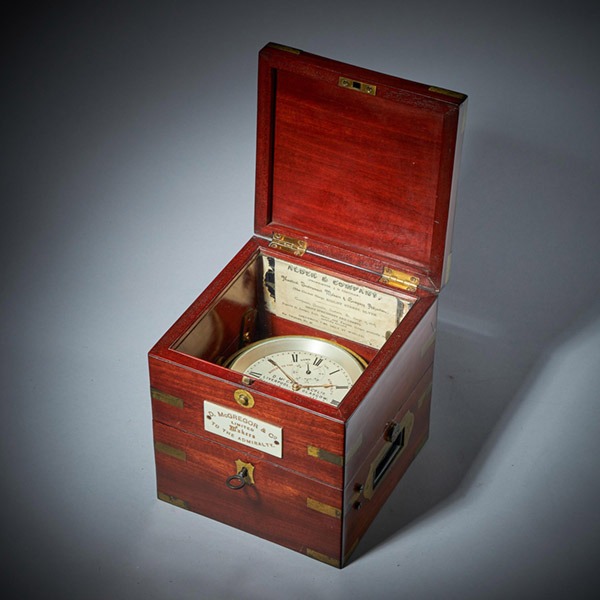
Fine Scottish Two-Day Marine Chronometer Signed and Numbered D. McGregor
Fine Scottish Two-Day Marine Chronometer Signed and Numbered D. McGregor £6,500Follow UsFine...

A Rare Chinese Chippendale George III cabinet on stand, circa 1760 England
A Rare Chinese Chippendale George III cabinet on stand, circa 1760. England £38,000Follow UsA Rare...

George III mahogany spider-leg table attributed to Thomas Chippendale 1768
A George III mahogany spider-leg table attributed to Thomas Chippendale 1768 £12,000Follow UsA...

Museum Grade George I Cocus Wood Card Table, Circa 1725, England
Museum Grade George I Cocus Wood Card Table, Circa 1725. England £32,000Follow UsMuseum Grade...

A Rare and Important Charles II 17th Century Table Clock by Henry Jones
A Rare and Important Charles II 17th Century Table Clock by Henry Jones £85,000Follow UsA Rare and...

Important Early Edo Period 17th Century Miniature Japanese Lacquer Cabinet
Important Early Edo Period 17th Century Miniature Japanese Lacquer Cabinet £36,000Follow...

Fine Scottish Two-Day Marine Chronometer Signed and Numbered D. McGregor
Fine Scottish Two-Day Marine Chronometer Signed and Numbered D. McGregor £6,500Follow UsFine...
